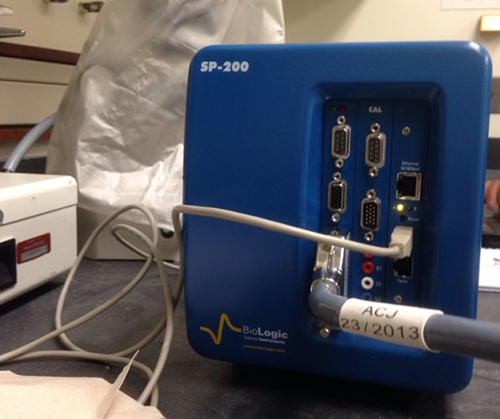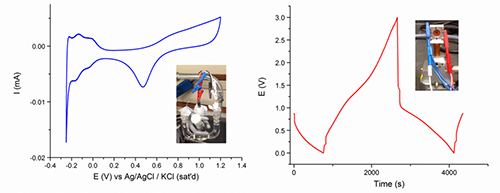X-RAY RUNS: Apply for Beamtime
2017 Nov 1 - Dec 21
2018 Feb 7 - Apr 3
2018 Proposal/BTR deadline: 12/1/17
2018 Apr 11 - Jun 4
2018 Proposal/BTR deadline: 2/1/18
CHESS has recently procured a Bio-Logic SP-200 potentiostat, an instrument that controls a three-electrode cell in electrochemical experiments, thanks to funding from the Energy Materials Center at Cornell. Key features of the SP-200 model (Figure 1) are found here.

Figure 1: Bio-Logic SP-200 potentiostat.
In the past, users performing electrochemical experiments at beamlines brought their potentiostats from their home laboratories. Because they are delicate, there is a risk of breakage of their internal components while transporting them, adding delays to users’ research programs if they do break. By having one at CHESS, users no longer need to bring one from their laboratories. There are several advantages of the Bio-Logic model. First, because of its portable design, it can easily be set up at different stations. Secondly, experiments can be remotely controlled via USB or Ethernet connection on the communication board on the instrument. In addition, because various types of experiments can be configured easily on the instrument’s software, users who are not be familiar with the Bio-Logic model can set up their experiments with minimal effort.
CHESS research associate, Peter Ko and CHESS graduate students in Prof. Abruña’s group (Chemistry, Cornell) James Pastore and Katie Silberstein, along with Ryo Wakabayashi, a graduate student also in Prof. Abruña’s group performed several initial tests with a platinum wire and a battery. The results from the tests are highlighted in Figure 2.
To request the potentiostat for your experiments at CHESS, contact Peter Ko (jpk96).

Figure 2: Left: A cyclic-voltammogram of a platinum wire in 0.1 M sulfuric acid. Right: A charge-discharge cycle of a battery. An inset in each graph shows the corresponding experimental setup.
Submitted by: Peter Ko, CHESS, Cornell University
09/04/2014
